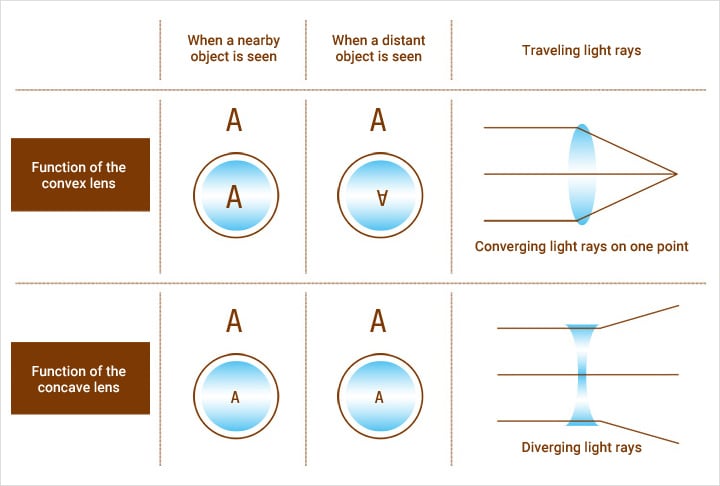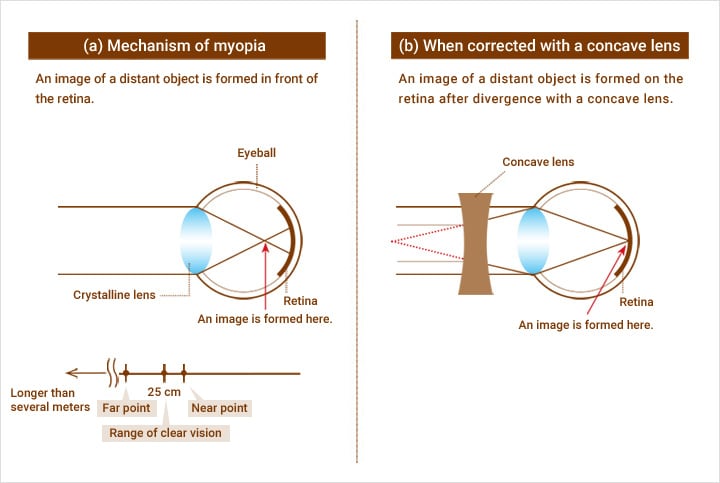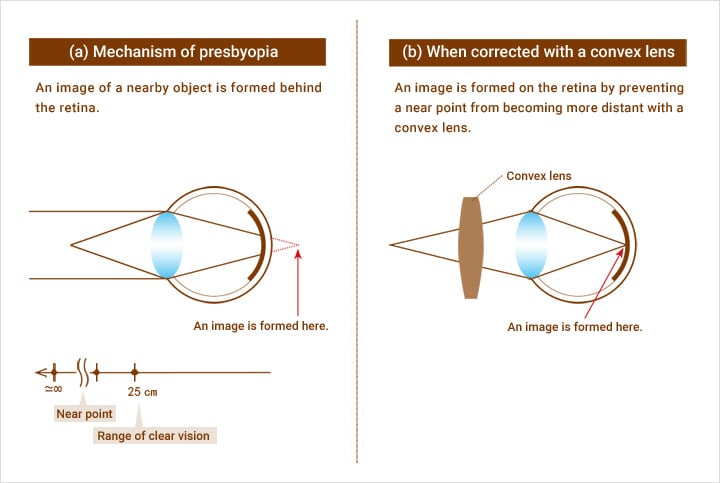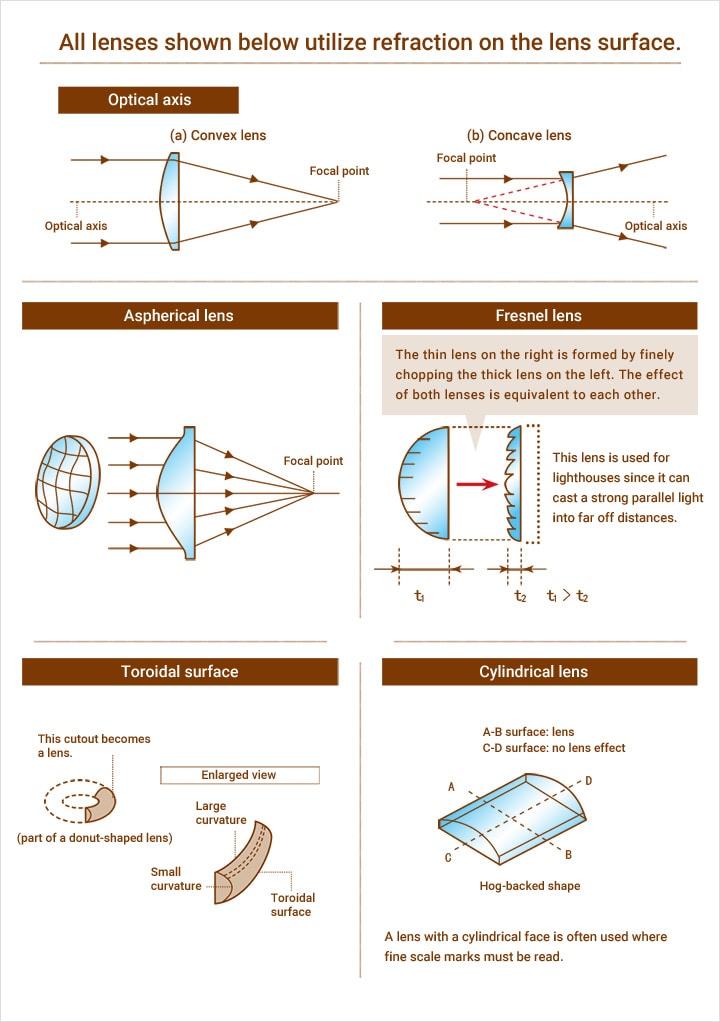History of Machine Vision : Lens
In order to achieve stable image processing, it is essential to have the right selection of lenses best suited for the application based on the knowledge of lens characteristics. There are many different types of lenses, each of which provides different effects, and are categorized according to their shape and material characteristics. This booklet introduces the history of the lens from its early origins to today.
Creation of Concave and Convex Lenses
The word lens comes from the Latin name lentil, native to the Mediterranean area. It is an example of an imported word that was called ‘tokyo (transparent mirror)’ by Japan during World War II. Its origin can be traced back to the crystal or glass balls used as fire-making tools at religious ceremonies or as accessories in ancient civilizations. It is generally accepted that the origin of the lens can be traced back to the ancient Roman philosopher, Seneca, who described, “letters could be magnified by a ball of crystal” about 2000 years ago.
The lens works using a principle known as light “refraction”: the light bends and changes its direction of travel. The convex lens, which is spherically-shaped with a thicker middle part, converges rays of light; while the concave lens, which has a hour glass shape with a thicker periphery, diverges rays of light.

Uses of Concave and Convex Lenses
The lens has been evolving through two fields: the eyeglasses we wear daily in our lives, and tool applications such as lenses used for microscopes, telescopes, and cameras. The first eyeglasses, put into practical use in the 13th Century, were actually a reading glass (simple magnifier) using the convex lens. In the beginning, it was called the “devil’s tool”. Meanwhile, eyeglasses with two lenses appeared, and eyeglasses for myopia (nearsightedness) using concave lenses were invented in the 16th Century.
Which was invented first, the microscope or the telescope?
The correct answer is the microscope, it was invented at the end of the 16th Century. Subsequently an Englishman, Hooke, developed a compound microscope using two convex lenses (objective lens and ocular), and in almost the same period, a single lens microscope was first developed in the Netherlands. The telescope was invented by a Dutchman, Lippershey, who used a convex lens as an objective lens and a concave lens as an ocular lens. It was Galileo who immediately refined this invention and used it for astronomical observations; he was able to use this device to discover the rings of Saturn. Also, a German astronomer, Kepler, devised the Keplerian telescope that used convex lenses as both objective and ocular lens.


Types of lenses
The concave and convex lenses are subdivided into many different types including: the spherical lens with a rounded surface, aspherical lens with curved surface profiles that are not spherical, cylindrical lens with a hogbacked profile, a toroidal lens that is shaped like a part of a donut, and the Fresnel lens with a washboard-like surface. On these lenses the light is refracted on the surface of the lens. While there are other types of lenses including the GRIN lens (gradient index lens) that produces optical effects by providing a gradual variation of the refraction index to the lens material and not by refraction on the lens surface or the diffractive lens that utilizes the phenomenon of the spreading out the light waves. The GRIN lens is often used for endoscopies and the diffractive lens for CD and DVD players.
| Lens utilizing refraction on the surface | Spherical lens |
|---|---|
| Aspherical lens | |
| Cylindrical lens | |
| Toroidal lens | |
| Fresnel lens |
| Lens using a mechanism other than refraction on the surface | GRIN lens (gradient index lens) |
|---|---|
| Diffractive lens |
Types of lens shapes
All lenses shown below utilize refraction on the lens surface.

Change in Lens Materials: from Glass to Plastics
Early lenses and crystal were luxury items that were not easy to obtain. The production of glass lenses started to increase due to the improvement of glass-making techniques in the 12th Century; then in the 19th Century the high transparency optical glass lens was invented. The optical lens played the key role in the 20th Century, and now there are over 200 types of them. They can be roughly divided into two types: the crown glass type with low refraction index which contains soda lime and the flint glass type with a higher refraction index which contains lead. The optical plastic lens appeared in the early 20th Century, but the light transmission rate and refraction index were low on the early models. It spread rapidly after thermosetting plastic was developed in the 1940s. Following this new development, thermoplastic lenses were made to have transparency comparable to optical glass, but only weighed half as much. This plastic lens contributed to the development of contact lenses and instant cameras because it is easy to mold, hard to break, and inexpensive to make. Recently these lenses have been used in eyeglasses and cell phone cameras. Other lens materials include quartz, fluorite, optically transparent ceramics, infrared-transparent halite, silicones and germanium.
Optical lens (Crown glass, Flint glass)
| Refraction index | Abbe’s number (Dispersion) | Properties of materials | |
|---|---|---|---|
| Crown glass | Small | Large (Small) | Hard and light |
| Flint glass | Large | Small (Large) | Soft and heavy |
Change in Camera Lenses: from Single Focus to Zoom
When a lens consists of a single optical element, it is called a “simple lens”; a lens made up of a number of optical elements is called a “compound lens”. After 1839 when the first silver halide camera, a daguerreotype, was invented, the compound lens technology improved tremendously, spurring the development of new types of lenses. These lens types include the Davidson type in which two joined meniscus lenses were placed symmetrically, the Petzval type which shortened the time required for photographing, the Triplet type with three separable lenses that succeeded the Petzval type, the Tessar type and the Sonnar type. In the 20th Century, the zoom lens was invented. The arrival of the zoom lens that can change focal lengths within one lens marked a breakthrough in the development of high performance lenses. These lenses cover a wide field of view using standard, wide angle, and telephoto focal lengths as well as high magnification. Subsequently, many types of variants were developed due to further enhanced magnification, weight reduction, and downsizing. The lens world has also entered a period of systemization.

Latest Lens Technology
Lenses are used in just about every electronic device: for example, the collimating lens in a CD-ROM drive that reads red LED laser beams, the scanning lens in laser printers, and the lens in the optical fiber scope that is used for barcode readers and endoscopes. Another example is the projection lens of a cutting-edge stepper (Step-and-Repeat projection exposure system) that enables semiconductor processing in micron scale is a precision lens made of layers of top-quality vitreous silica. It is known as the “king of lenses”.
In summary, one might ask, “What is the best camera lens in human history?” The answer is “a human eye (crystalline lens)”, which freely adjusts its thickness to gain an appropriate focal length. In fact, the state-of-the-art lens, modeled on the crystalline lens, is now under development. It is called a liquid lens. This lens made from two kinds of fluid of different conductivity, insulation property, and refraction index can freely change the focal length by adjusting the thickness and form of the lens using surface tension effects. Since it requires neither a focusing mechanism nor a drive unit, it is expected to be used in an array of applications through a wide range of industries from home electronics and medical equipment to the security field.

![A Technical History of Image Processing Vol.1 [Camera]](/img/asset/AS_46814_L.jpg)




![The Latest Image Processing Applications [Transportation Industry]](/img/asset/AS_71759_L.jpg)

![The Latest Machine Vision Inspections [Food and Medical Industries]](/img/asset/AS_72814_L.jpg)








